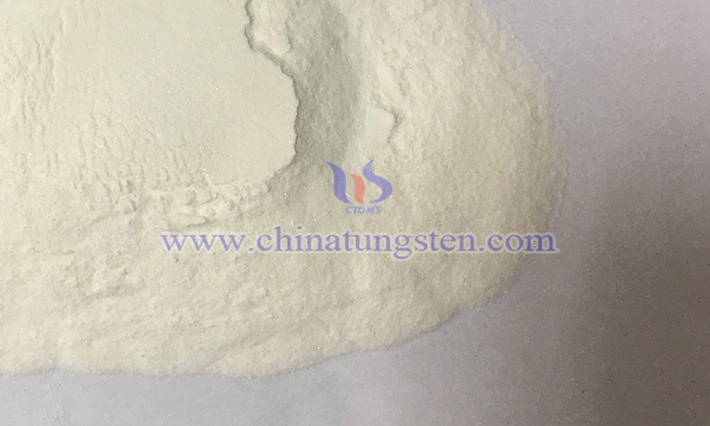What Are the Production Processes of Ammonium Metatungstate?
- Details
- Category: Tungsten Information
- Published on Friday, 25 April 2025 16:36
Ammonium metatungstate (AMT) is a tungsten compound widely used in catalysis, electronics, ceramics, and other fields. Its production processes vary, each with unique advantages and suitable applications.
1. Neutralization Method
The neutralization method is the most commonly used for producing AMT due to its relatively simple process and low equipment requirements. The process begins with the reaction of tungstic acid (H₂WO₄) and ammonia water (NH₃·H₂O), forming an ammonium tungstate solution through a neutralization reaction. Key to this step is controlling reaction conditions such as temperature, ammonia concentration, and addition rate. Next, an acid (typically nitric acid) is added to adjust the pH of the ammonium tungstate solution. At a specific pH, tungstate ions in the solution gradually polymerize into AMT; precise pH control is critical, as deviations can affect product purity or yield. After polymerization, the solution is concentrated by evaporation to remove excess water and increase AMT concentration. The solution is then cooled to allow AMT crystals to precipitate. The crystals are separated from the mother liquor via filtration, washed with a suitable solvent to remove surface impurities, and finally dried to obtain the finished product.
Advantages: Simple process, suitable for large-scale production.
Disadvantages: High dependency on raw material purity and reaction conditions, where impurities or imprecise operations can impact product quality.

2. Sodium Tungstate Transformation Method
This method uses sodium tungstate as a raw material, making it suitable for utilizing cost-effective tungsten resources. The process starts by mixing a sodium tungstate solution with calcium chloride to form insoluble calcium tungstate precipitate. Optimizing reaction conditions like temperature, solution concentration, and stirring speed ensures a thorough reaction. The calcium tungstate precipitate is then reacted with hydrochloric acid to convert it into tungstic acid precipitate, requiring careful control of acid quantity and concentration to avoid over- or under-reaction. The resulting tungstic acid reacts with ammonia water to form an ammonium tungstate solution. Subsequent steps mirror the neutralization method: pH adjustment, evaporation concentration, cooling crystallization, filtration, washing, and drying to produce AMT.
Advantages: Lower cost of sodium tungstate raw material, suitable for specific tungsten resources.
Disadvantages: More process steps, higher energy and material consumption, and a relatively complex workflow.
3. Ion Exchange Method
The ion exchange method leverages the adsorption properties of ion exchange resins to purify tungsten, ideal for scenarios requiring high-purity products. The process starts by passing a tungsten-containing solution (e.g., pre-treated tungsten raw liquid) through an ion exchange resin column. Tungstate ions are adsorbed by the resin, while other impurity ions remain in the solution. The choice of resin is crucial, as different resins have varying adsorption capacities for tungstate ions. Once the resin is saturated, a desorbing agent like ammonia water is used to elute the tungstate ions, forming an ammonium tungstate solution. The remaining steps are similar to previous methods: concentration, crystallization, filtration, washing, and drying to obtain AMT.
Advantages: High product purity, effective impurity removal, and flexible process.
Disadvantages: High cost of resins, which require periodic replacement or regeneration, increasing production costs. Best suited for applications demanding extremely high product quality.

4. Solvent Extraction Method
The solvent extraction method separates tungsten based on solubility differences between aqueous and organic phases, offering an efficient process. First, an organic solvent with good extraction ability for tungstate ions, such as organic phosphorous extractants, is selected. The tungsten-containing solution is mixed with the organic solvent under suitable conditions (temperature, pH, and extraction time), transferring tungstate ions from the aqueous phase to the organic phase. After extraction, the organic and aqueous phases are separated by settling. Then, a stripping agent like ammonia water is used to transfer the tungstate ions back to the aqueous phase, forming an ammonium tungstate solution. The subsequent steps are concentration, crystallization, filtration, washing, and drying to produce the final product.
Advantages: High extraction efficiency, strong selectivity, and ability to process low-grade tungsten raw materials.
Disadvantages: Use of organic solvents poses safety and environmental risks, and solvent recovery and disposal add complexity to the process.
| Molybdenum Supplier: Chinatungsten Online www.molybdenum.com.cn | Tel.: 86 592 5129595/5129696 Email:sales@chinatungsten.com |
| Tungsten News & Prices: Chinatungsten Online news.chinatungsten.com | Molybdenum News & Molybdenum Price: news.molybdenum.com.cn |



 sales@chinatungsten.com
sales@chinatungsten.com